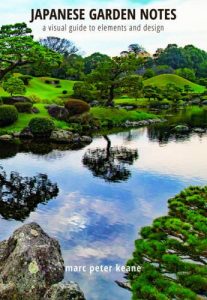JQ Magazine: Book Review — ‘Japanese Garden Notes’

Keane is the perfect person to expound on the finer aspects of the Japanese garden. Reading Japanese Garden Notes basically transports you to a museum as the text is similar to the interpretation you’d receive from a seasoned docent. (Stone Bridge Press)
By Rashaad Jorden (Yamagata-ken, 2008-10) for JQ magazine. A former head of the JETAA Philadelphia Sub–Chapter, Rashaad is a graduate of Leeds Beckett University with a master’s degree in responsible tourism management. For more on his life abroad and enthusiasm for taiko drumming, visit his blog at www.gettingpounded.wordpress.com.
One Golden Week afternoon after exploring Okayama Castle, I decided to stroll over to nearby Kōraku-en Garden. Mainly because it was there and I wasn’t sure what else to do in Okayama. But once I stepped on the premises of the garden, a sense of serenity fell over me as did the feeling I felt like I had found a gem, as well as a place where time stood still.
What is the world of these elegant locales like? Landscape architect and author Marc Peter Keane answers that question and more in Japanese Garden Notes: A Visual Guide to Elements and Design.
It’s clear that Keane, a garden designer and Kyoto resident for roughly twenty years, will explain “what makes a Japanese garden feel the way it does” largely through photographs. But what will readers be looking at? Pretty much Japanese Gardens 101, as each chapter bears the name of a concept or feature present in Japanese gardens like meandering paths, arbor bridges, streams, and more. A phrase further describing the main concept appears prior to the explanations in each chapter and those descriptions run the gamut from the profound (“A meandering path is full of surprises”) to the explanatory regarding the appearance of the garden (“Linking a distant part of the garden with the foreground”) to the borderline hilarious (“Japan is wet, thus the dry garden.”).
Keane is the perfect person to expound on the finer aspects of the Japanese garden. Reading Japanese Garden Notes basically transports you to a museum as the text is similar to the interpretation you’d receive from a seasoned docent.
The language Keane uses to educate readers about Japanese gardens is relatively simple and nothing remotely academic. The author also at times resembles an old man telling stories about life back in the day (“Seeing the changes reminds you of what has gone,” he writes in the section devoted to utsuroi (change), adding “you sense that is the only permanent thing”). That rather conversational tone makes Japanese Garden Notes a pleasant read, such as when Keane outlines the simple (or maybe not so simple) steps of making a path comprised of small stones. Keane comes alive as a tour guide when detailing the various aspects of Japanese gardens.
The captions of the photographs also provide interesting tidbits about these gardens, even when some of the captions don’t say anything profound (“The garden is a place within which to contemplate the passing of the seasons”) or are just explanatory. But several of them reveal how the objects in the pictures enhance the appearance of the Japanese garden (“The arrangement of unusual stones and a pine tree represents a crane island: a symbol of longevity”). A lot of gardens are represented visually in the book and every page features at least one photograph, which puts the concepts and features that Keane illustrates into practice.
It’s fitting that the author compiled a large list of features that complete a Japanese garden. As he notes, “this attention to detail pervades the whole culture of Japan and is evident in the design of its gardens as well.” Keane excels at conveying how seemingly miniscule details contribute significantly to creating a peaceful, soothing atmosphere. While Japanese Garden Notes is not in any way the first book to turn to in order to obtain extensive historical background about Japanese gardens, it captures the elegance of such a calming place.
For more on Japanese Garden Notes, click here.
For more JQ magazine book reviews, click here.


Comments are closed.